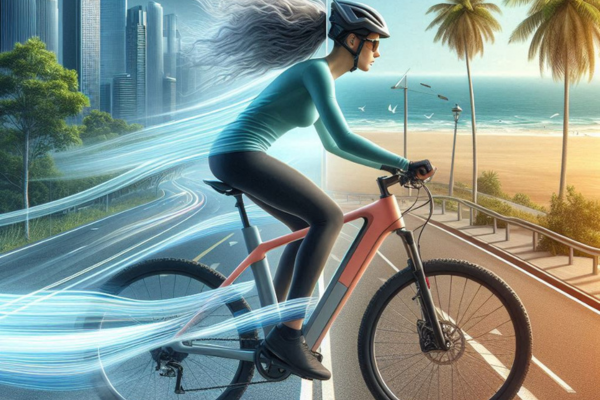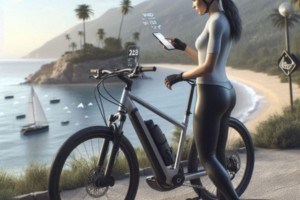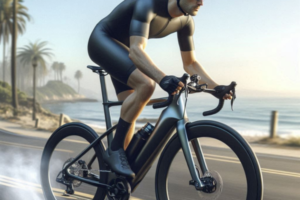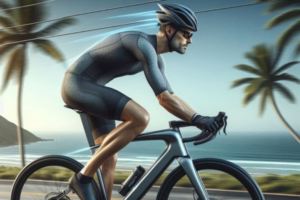🌍 Understanding Terrain and Its Impact on Wind Resistance
Whether you’re commuting through the city or cruising along a coastal bike path, the terrain beneath your wheels plays a major role in how the wind affects your ride. Wind resistance is not a one-size-fits-all experience—it varies dramatically depending on where you’re riding, the layout of your environment, and the physical characteristics of the landscape. For e-bike riders, who often travel at consistent speeds, understanding these terrain dynamics can make every kilometer smoother, safer, and more energy-efficient.
Wind resistance—or aerodynamic drag—is the force that air exerts against a moving object. The faster you go, the more wind resistance you encounter. But here’s what many riders overlook: terrain determines how that air moves. In urban areas, wind is shaped by buildings, streets, and alleys. In coastal regions, the openness of the landscape exposes you to crosswinds, headwinds, and gusts without warning. That means your terrain doesn’t just determine elevation and grip—it directly influences how much energy your motor and your body must expend.
🏙️ Urban Terrain: Channels, Buffers, and Wind Tunnels
In cities, buildings act like massive wind directors. Depending on your location, wind can be blocked entirely or channeled into powerful gusts. As you ride between skyscrapers or along narrow alleyways, the airflow can become compressed, forming sudden “wind tunnels” that hit your bike from the side or rear. Conversely, trees, cars, and even other cyclists may serve as temporary wind buffers, reducing drag and providing micro-moments of calm.
- Advantages: Frequent shelter from buildings and vegetation can minimize wind exposure.
- Challenges: Wind direction can change instantly due to gaps, intersections, or bus lanes.
- Risk zones: Bridge crossings, wide avenues, and plazas with open layouts.
🌊 Coastal Terrain: Open Exposure and Constant Crosswinds
Riding near the ocean offers beautiful views—but also steady wind. Coastal terrain lacks vertical structures to block airflow, leaving you exposed to consistent breezes and unexpected gusts. Unlike the swirling or redirected wind in urban environments, coastal wind tends to be more predictable in direction but stronger in intensity. Sea breezes, driven by temperature shifts between land and water, can accelerate quickly and persist for hours.
- Advantages: Wide-open routes allow for visibility and fewer stops.
- Challenges: Constant wind exposure increases drag, requiring better clothing and bike setup.
- Risk zones: Cliffside paths, elevated trails, long causeways, or wide beach roads.
📊 Comparative Snapshot: Urban vs. Coastal Wind Conditions
| Terrain | Wind Pattern | Rider Impact | Adaptation Needed |
|---|---|---|---|
| Urban | Unpredictable, swirling, buffered | Sudden directional changes | Quick reflexes and steering control |
| Coastal | Steady, strong, open exposure | Continuous drag on rider and motor | Aerodynamic gear and consistent pace |
💡 Why It Matters for E-Bike Riders
E-bikes are built for efficiency, but wind resistance can reduce battery range, slow down average speed, and increase rider fatigue. Recognizing how terrain influences that resistance allows you to adapt proactively. Whether by adjusting your route, posture, gear, or clothing, you’re not just riding smarter—you’re riding in sync with your environment.
💡 Takeaway: The ground beneath you shapes the air around you. Master both, and your ride becomes effortless.
🌿 Terrain Features That Shape Wind Resistance: What Every E-Bike Rider Should Know
When we think about wind resistance, we often picture fast air hitting our bodies—but few riders realize how much the physical features around them influence that wind’s direction, strength, and behavior. From tall buildings to natural elevation changes, your riding environment is constantly shaping the air you move through. For e-bike commuters and adventurers alike, learning how to “read” the terrain is a game-changer for maintaining speed, stability, and comfort in windy conditions.
🏢 Urban Structures: Wind Amplifiers and Buffers
In urban landscapes, architecture doesn’t just provide shade or visual interest—it actively redirects wind. When breezes move through tight gaps between buildings, they accelerate. This effect, known as the Venturi effect, creates wind tunnels that can surprise even experienced cyclists. Corners and intersections are also danger zones where wind changes direction suddenly.
- Tall buildings: Create pressure zones and turbulence on both windward and leeward sides.
- Underpasses and tunnels: Brief calm zones often followed by sudden gusts at exits.
- Open plazas: Offer no wind protection and can channel strong bursts across the rider’s path.
On the other hand, smaller structures, fences, and parked vehicles can act as temporary wind shields. Knowing how to position yourself near these barriers can provide quick moments of relief in heavy gusts.
🌳 Natural Windbreaks: Trees, Hills, and Bush Lines
In semi-urban and coastal fringe areas, vegetation plays a powerful role in reducing drag. Thick rows of trees and bushes break up wind patterns, while gentle hills or ridges can shield sections of a road or trail. However, the protection they offer depends on height, density, and wind direction.
| Feature | Wind Resistance Effect | Rider Strategy |
|---|---|---|
| Dense tree lines | Break up strong wind; reduce crosswind sway | Ride parallel to tree cover when possible |
| Hills and natural berms | Act as wind shadows on the leeward side | Use them to your advantage when headwinds are strong |
| Open parks or flat fields | No barriers = high wind exposure | Lower your posture and reduce speed for control |
⛰️ Altitude and Elevation Changes
The higher the terrain, the more intense the wind exposure. Elevated bridges, ridgelines, and hillside roads are notorious for channeling strong gusts. Even gentle elevation changes can alter how you feel the wind—riding uphill reduces your relative wind speed, while descending can magnify its effect.
- Climbs: Require more power but feel less wind due to slower speeds.
- Descents: Increase exposure to wind resistance—essential to maintain posture and steering precision.
- Plateaus and overlooks: Offer spectacular views but little shelter—brace for open exposure.
🧠 Practical Insight for Smart Riding
Knowing how your environment shapes wind gives you a tactical edge. You can position your bike to maximize shelter, anticipate gusts at intersections, and choose gear or clothing that complements the terrain. For example, a low-profile riding position combined with side-buffering gloves can neutralize crosswinds in urban alleyways, while a windproof shell and wider tires offer control on open coastal cliffs.
💡 Tip: Don’t just look at the road—scan your surroundings. Terrain awareness leads to wind control.
📏 Adapting Your Riding Strategy to Terrain and Wind Resistance
When it comes to e-bike riding, the key to maintaining control and conserving energy is not to overpower the wind—but to adapt to it. Different terrains demand different strategies, especially when it comes to posture, speed control, and clothing choices. Riders who learn to fine-tune these three areas according to their environment not only ride more comfortably but also extend battery life, reduce fatigue, and improve safety.
🚴♀️ Posture Adjustments for Urban vs. Coastal Terrain
Your body position is your first aerodynamic tool. In coastal terrain, with its constant exposure to lateral winds, you need to streamline your profile to minimize drag. In contrast, urban environments often demand agility and quick response to swirling gusts or obstacles, so posture must balance aerodynamics with maneuverability.
- Coastal terrain: Lower your torso, keep elbows tucked in, and maintain a stable, forward-leaning posture to slice through headwinds and resist lateral pushes.
- Urban terrain: Maintain a relaxed but alert posture with slightly bent elbows to absorb sudden gusts; prioritize visibility and control over extreme aero position.
Regardless of the environment, avoid rigid arms or locked shoulders. Flexibility in your upper body allows you to absorb and respond to wind shifts, especially when turning corners or navigating narrow paths.
⚙️ Speed Management and Wind Behavior
Speed isn’t just about getting from point A to point B—on an e-bike, it directly affects how much wind resistance you experience. In urban environments, frequent stops and traffic slow you down, which means less drag overall—but more need for control during acceleration bursts. On coastal roads, your speed is steadier, and resistance builds consistently, requiring active energy management.
| Environment | Recommended Speed Strategy | Wind Response |
|---|---|---|
| Urban streets | Ride at moderate speed, brake early, accelerate smoothly | Less resistance but more unpredictable gusts |
| Coastal paths | Maintain steady pace; slow down on open sections with sidewinds | Constant wind drag; better efficiency with consistent cadence |
👕 Clothing Strategy by Terrain
Your gear can either work for you—or against you—when it comes to wind resistance. In coastal environments, sleek, wind-resistant layers are essential. In cities, layered flexibility is often more important due to stop-and-go movement and variable airflow. Either way, snug fits and moisture-wicking materials improve performance and comfort.
- For coastal rides: Wear long-sleeved aerodynamic jerseys, windproof vests, and tight-fitting shorts or tights to reduce drag and stay warm against breezes.
- For urban routes: Choose breathable base layers and packable wind shells that allow quick adjustments when transitioning between sun and shadow or during unexpected gusts.
- Pro tip: Avoid flapping fabrics or loose jackets in any terrain—wind will catch them and increase both drag and instability.
🧠 Tactical Summary for Smarter Riding
Terrain changes everything. Riding smart means not just pushing forward—but adapting how you ride. Lower your posture when wind is strong. Adjust your pace when riding exposed. Dress like the wind is part of your plan, not an obstacle. These small decisions add up to big benefits: improved efficiency, better balance, and a much more enjoyable ride.
💡 Reminder: Wind is never just in your way—it’s part of the road. Adapt, and you ride through it, not against it.
🧭 Route Planning Checklist: Optimize Your Ride Based on Wind and Terrain
Choosing the best route for your e-bike ride isn’t just about avoiding traffic—it’s about riding smarter in relation to wind resistance, terrain exposure, and your energy management. Riders who factor in wind patterns and environmental features when planning their path can reduce fatigue, improve ride time, and avoid unpleasant surprises. This is especially crucial in coastal or urban landscapes where wind conditions shift quickly and terrain changes constantly.
✅ Pre-Ride Terrain & Wind Resistance Checklist
Use this checklist before each ride to assess how wind and terrain might affect your route:
- ✔️ Check wind forecast: Use apps like Windy, AccuWeather, or your favorite local service. Look for gust intensity, direction, and sustained wind speed.
- ✔️ Analyze terrain exposure: Are there open areas like bridges, beaches, or wide roads? Or are you riding between buildings or behind trees?
- ✔️ Note elevation changes: Identify hills, causeways, or descents where wind might intensify.
- ✔️ Map shelter points: Locate sections protected by infrastructure (walls, vegetation, rows of houses).
- ✔️ Assess traffic zones: Avoid streets where wind could push you toward vehicles—especially during strong crosswinds.
🗺️ Choosing the Right Route: Urban vs. Coastal Scenarios
Different environments require different navigation logic. Here’s how to choose wisely:
| Scenario | Route Strategy | Why It Works |
|---|---|---|
| Urban with light wind | Use bike lanes between buildings to buffer wind; avoid intersections during peak gust times | Structures block and redirect wind, creating microzones of stability |
| Coastal route with steady wind | Start riding into the wind, return with a tailwind | You use energy early, then ride effortlessly back |
| Mixed elevation terrain | Avoid steep open ascents during high wind alerts; seek tree-lined or low-altitude alternatives | Reduces instability and motor strain uphill |
| Post-storm windy day | Choose sheltered urban routes with lower traffic; avoid bridges or coastlines | Safety and visibility improve when gust exposure is minimized |
🔄 When to Adjust Mid-Ride
- Wind gets stronger than forecasted: Shift to side streets or ride in the wind’s direction to reduce resistance.
- Unexpected gusts in open areas: Lower your speed, tighten your grip, and seek the next shelter zone.
- Battery draining fast due to headwinds: Shorten your route using backroads or loop back with a tailwind.
🧠 Mindset Tip: Ride With Awareness
Great riders don’t just prepare their bikes—they prepare their minds. Treat every ride like a tactical route, not a random adventure. When you know the terrain and forecast, you’re not riding into surprise—you’re riding with strategy.
💡 Takeaway: The best route isn’t always the shortest—it’s the one that lets you ride in harmony with the terrain and wind.
💬 Frequently Asked Questions (FAQs)
1. How much does terrain really affect wind resistance?
Terrain plays a significant role in shaping how wind interacts with your body and bike. Coastal areas tend to have open exposure, which increases drag, while urban areas can block or funnel wind unpredictably. Understanding your environment lets you anticipate wind behavior and adjust your riding posture and route accordingly.
2. Is it worth changing my route just to avoid wind?
Absolutely. A smarter route with more wind protection may save you energy, battery power, and even time, especially on longer rides. Wind resistance increases exponentially with speed, so even a mild headwind on an exposed road can lead to faster fatigue or range loss on an e-bike.
3. What’s the best way to ride in crosswinds?
Maintain a firm but flexible grip on the handlebars, lean slightly into the wind, and stay low to reduce your side profile. Try to anticipate wind-prone sections such as bridge crossings, open valleys, or coastline bends, and reduce speed for greater control when needed.
4. Can clothing really make a difference in wind resistance?
Yes. Tight-fitting, aerodynamic clothing reduces drag and fluttering, which not only improves speed but also makes your ride more stable. Loose garments can catch the wind, creating imbalance and increasing the strain on your body and bike motor.
5. How do I know if wind is too strong to ride?
If sustained winds exceed 40–50 km/h (25–30 mph), especially with strong gusts, it may be safer to postpone your ride or choose sheltered urban routes. Wind this strong can impact balance, steering, and safety—particularly on elevated or exposed terrain.
💖 Final Thoughts: Let the Wind Guide Your Wisdom
Riding an e-bike isn’t just about getting from one point to another—it’s about learning to flow with your environment. Wind isn’t your enemy, and terrain isn’t just the surface beneath you. Both are elements in a greater conversation between you and the road.
When you learn how to listen to the land and adjust to the air, you become more than a rider—you become a strategist. Every gust becomes predictable. Every turn becomes intentional. And every ride becomes a lesson in moving forward, not just with force, but with finesse.
So take the time to observe your surroundings, adapt your posture, plan your routes, and gear up with purpose. You don’t have to fight the wind to enjoy your ride—you just have to understand it.
💡 Inspiration: Great riders don’t wait for perfect conditions—they learn to ride smart in every terrain.
🌍 Join the Conversation: What’s Your Smartest Route Strategy?
We’d love to hear from you. Do you have a go-to route that helps you avoid headwinds or take advantage of natural wind barriers? Have you found the perfect balance between scenic and sheltered rides? Your experience could help a fellow e-bike rider make smarter decisions tomorrow.
Share in the comments:
🧭 What’s the most wind-smart route you’ve discovered?
🌬️ How do you prepare for rides when the forecast calls for wind?
🚴♀️ What’s your #1 tip for handling terrain and wind in harmony?
Let’s keep building a thoughtful, supportive community where every ride is more than distance—it’s knowledge in motion. 🌟



